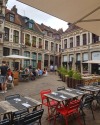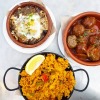There is much good eating to be found in Amsterdam, including a wide range of Dutch food specialities and favourites that are well worth seeking out.
Appeltaart
Apple pie, cake or tart is popular in the Netherlands, and in Amsterdam we often saw an enormous apple pie, under its protective glass dome, atop many a bar and cafe counter and on many restaurant menus.
Bamiblok
This unusual recipe involves pressing noodles into a block shape, rolling the block in breadcrumbs and deep frying it. It is sometimes made in other shapes such as bamischijf (disc-shaped). This popular snack is usually accompanied by one of a large range of sauces; see Patat/ Friet, below, for an idea of the range.
Drop
Liquorice is one of the most famous and popular Dutch sweets and is available in a range of shapes and flavours. Zoute drop means ‘salty liquorice’, also known as salmiak (for the ammonium chloride in the recipe). Zoete drop means ‘sweet liquorice’ and flavours include mint, honey and laurel. English liquorice allsorts are known as Engelse (English) drop .
Frikandel
Sausage-shaped, but skinless, this minced-meat snack is are more like a burger in texture and taste, but is deep fried. Developed in the middle of the last century, it’s become one of the most popular snacks in the Netherlands. Most often served with curry ketchup, mustard or mayonnaise it’s also enjoyed with a combination of mayonnaise, curry ketchup and raw onion, in which case it’s called frikandel speciaal.
Gehaktbal
Meatballs are one of those universal dishes; so many cuisines have a version of these in one form or another. In the Netherlands they are often served plain or in a simple tomato sauce.
Haagse Hopjes
Originating from The Hague in the 18th century, these coffee caramel cream sweets are individually wrapped in distinctive packaging.
Hete Bliksem
I love the name of ‘hot lightning’ for this simple dish of boiled potatoes and apples (a mix of sour and sweet) served with stroop (treacle syrup) and an optional scattering of bacon or ham. Variations include the addition or substitution of pears for apples and a thunder and lightning version in which ham and mustard are added.
Kaas
Kaas is the Dutch for cheese. Traditional pubs often offer one or more Dutch cheeses on their bar snacks menu. As well as plain cheeses, versions with cumin, herbs and other spices added are also popular. You may find smoked cheeses too.
Kaassoufle
This cheese snack, popular throughout the Netherlands consists of hot liquid cheese inside a deep fried bread crumbed casing.
Kroket/ Bitterbal
Another very typical Dutch snack, croquettes are most commonly filled with meat ragout, but other fillings are also popular. A great choice with a glass of beer. Kroketten are formed into a short sausage shape. A smaller, round version are known as bitterballen.
Maatje
Herring from the North Sea has been a staple of the Dutch diet for centuries. Today, maatjes are a popular snack available from stands around the city. Maatje derives from the Dutch word for ‘virgin’, by the way and refers to the fact that the best herring is caught after the fish have gorged on food but before they’ve had a chance to reproduce.
Though most guides describe maatjes as raw herrings, in fact they are very lightly soused (preserved) in brine. The gills and part of the gullet are removed, to eliminate bitterness, but the liver and pancreas are left in place during the pickling, as the pancreatic enzymes they release are said to contribute to the flavour.
In days gone by, there was much excitement when the herring season started as the nieuwe haring (new herring) was particularly prized for its oil-rich flavour. These days, all herring must be frozen following the catch (to kill nematodes) which means the best fish is available all year round.
The meltingly soft fish is usually served chopped into pieces, with diced raw onion and pickled gherkins, on a small paper tray. For a more filling version, opt for broodje and the vendor will stuff the fish, onion and pickles into a soft bread roll.
Oliebol
Literally ‘oil balls’, oliebollen are Dutch doughnuts, traditionally made to celebrate New Year’s Eve and also popular at funfairs. They are also sold from street stalls, most commonly during winter. Sometimes dried fruits, pieces of apple or citrus zest are mixed into the dough.
Pannenkoek
Dutch pancakes are thinner than American or Scottish ones, but thicker than French crepes and are usually much larger, often up to a foot in diameter. Savoury pannenkoeken often have bacon, apples and cheese added. Plain or sweet ones are usually served with treacle syrup or icing (powdered) sugar.
Patat/ Friet
French fries are ubiquitous in Amsterdam and a very popular snack or quick meal. They are most often served with mayonnaise but you may also find them offered with curry ketchup, variations of mayonnaise such as garlic or curry, Indonesian-inspired sate peanut sauce, speciaal – a mix of mayonnaise, curry ketchup and chopped raw onion, samurai – mayonnaise mixed with sambal oelek (Indonesian chilli paste) or oorlog (‘war) – a (perhaps jarring, given the name) mix of mayonnaise, peanut sauce and raw onion, though it can also be a combination of other sauces and toppings on offer from that vendor.
Poffertjes
These tiny fluffy pancakes made in specialist pans with shallow indentations into which the batter is poured. They are usually served hot with melting butter and icing (powdered) sugar and are enjoyed as a sweet snack or dessert.
Rijsttafel
Just as Indian food has become a national institution in Britain, given our country’s history in India, so Indonesian food is similarly prevalent in the Netherlands. Many Amsterdam restaurants offer the rijsttafel, which translates as ‘rice table’ and describes a meal in which tiny portions of many dishes are served together, along with rice.
Rookworst
Rookworst translates as ‘smoked sausage’, and is made from ground meat, spices and salt stuffed into a sausage casing and smoked. These days, smoke flavourings are sometimes used as a short cut. Rookworst is traditional served with stamppot.
Speculaas / Speculoos Paste
I love speculaas – delicious thin and crunchy spiced shortcrust biscuits, traditionally baked for St Nicholas’ Feast (December 5th) but nowadays available all year round. Often, the biscuits have a picture stamped onto the front before baking
A related delight is speculoos paste (note the French/ Flemish spelling variation), which you can buy in jars from grocery shops. The biggest brand making this seems to be Lotus but others, such as Vermeiren make it too. Thick and spreadable, I’m intending to enjoy the contents of my jar on toast, and maybe as a tasty cake filling.
Spekkoek
Despite the Dutch name translating to ‘pork belly’ or ‘bacon’, spekkoek is actually a cake; another Indonesian dish which has become very popular in the Netherlands. The stripes of cake, built up layer by layer, resemble streaky pork belly bacon. The cake is very rich, containing lots of egg yolks, butter and sugar and is laborious to make. In Indonesian, the cake is known as sweet layer cake or thousand layer cake, and is enjoyed during special celebrations. In the Netherlands, it is often served as dessert in rijsttafel restaurants.
Stamppot
Stamppot means ‘mash pot’ and is a really comforting winter warmer of a dish made from mash potatoes with the addition of onion, bacon and one of a range of leafy green vegetables. Rookworst is often served on top.
Stroopwafel
Much thinner and denser than the light, fat waffles I’m more familiar with, these circular beauties are two thin layers of pressed batter with a treacle syrup filling which has a lovely caramel flavour. These lovely chewy snacks are enjoyed fresh from roadside stands but cold, ready made ones sell very well too.
Tompoes /Tompouce
Although tompoes means ‘tom cat’ or ‘tom puss’ the name actually derives from tompouce, as it’s still sometimes written, i.e. ‘Tom Thumb’. It refers to a traditional pastry made from two layers of puff pastry, a filling of sweet pastry cream and a smooth layer of pink icing on top. The colour varies only on and just before Queen’s Day, when it is orange instead of pink, to reflect the main colour of the Royal Standard.
Wilhelmina Pepermunt
These simple, crumbly peppermint sweets are named for a former queen and come with her likeness embossed on their surface. Available from sweet shops and kiosks, we were often given a couple with the bill at cafes and restaurants.
With thanks to Eurostar for return train tickets to Amsterdam and the first night’s hotel stay.












Please leave a comment - I love hearing from you!8 Comments to "Eating In Amsterdam: An A to Z of Food Specialities"
I’m not a great lover of sweet stuff and found Amsterdam very heavy on sweet/sweetened snacks. Looking forward very much to reading your restaurant recommendations for next time we go!
I have *got* to get back to Amsterdam soon *looks at calendar with dismay*
I go on Friday so this is great!
Always wanted to visit Holland and especially Amsterdam – although my husband went before we met and it’s never been a priority to go back. The new Eurostar route could change all that though!
Great list of dutch baked specialities – lots I’d not heard of before too.
My brother in law live there and we like to visit him once in a while. Will keep this places in mind when I am going there.
Great post with lovely pictures. I love Amsterdam! Such a beautiful city, so easy to walk about and soak up the atmosphere! And so vibrant. If I go, I always treat myself to Rijsttafel. We need to have the same approach to Indonesian food in London, for sure!
This brings back so many memories of our trip at Easter. Especially those poffertjes. If you know somewhere that sells them here please let me know as all the shops were closed the day we decided to go shopping!
Cheers for the recommendations of things to eat. I managed to eat a decent proportion of your list in our calorie packed 72 hours!